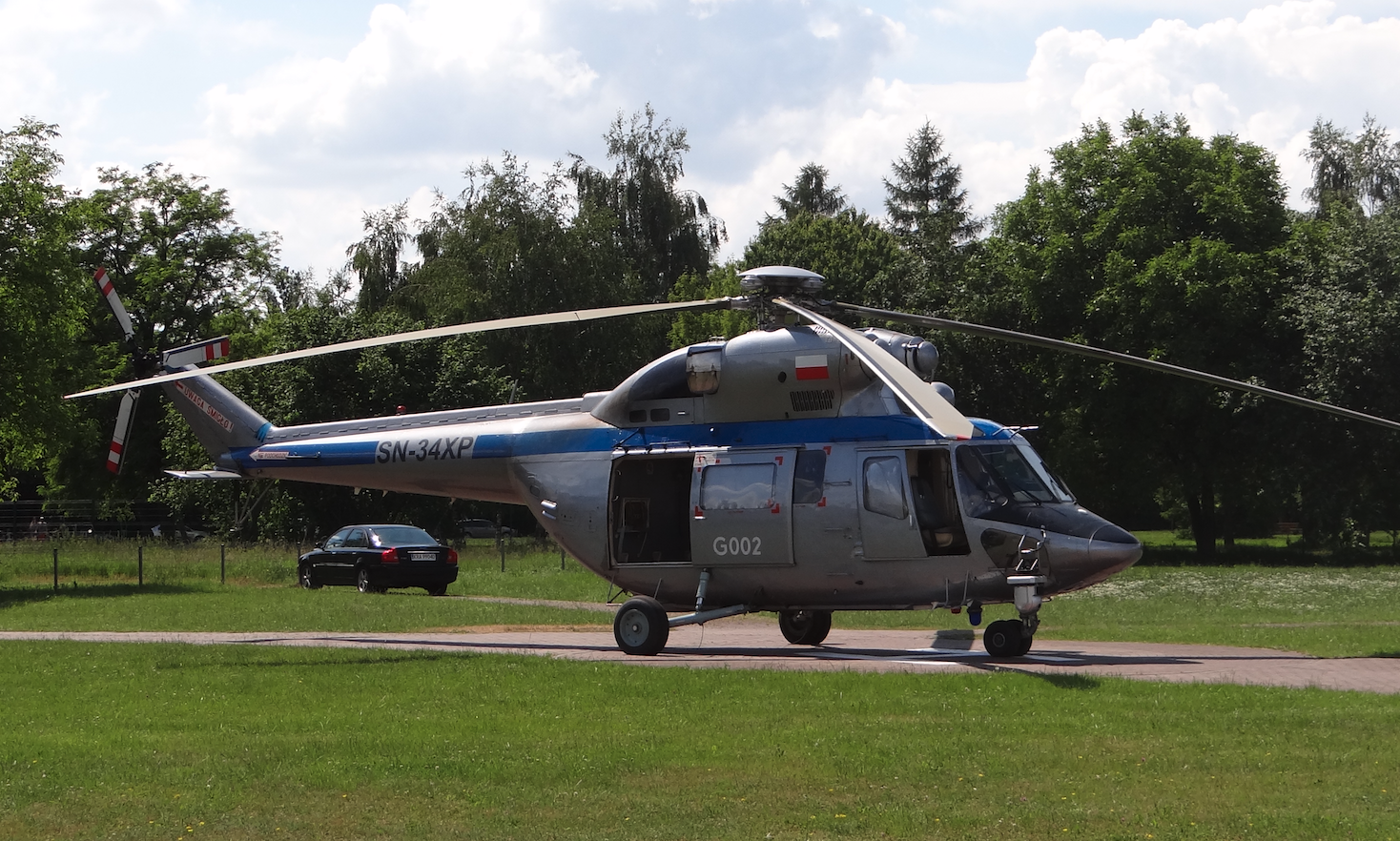Kraków 2025-06-11
PZL WSK Świdnik PZL W-3 Sokół SN-34XP, G-002.
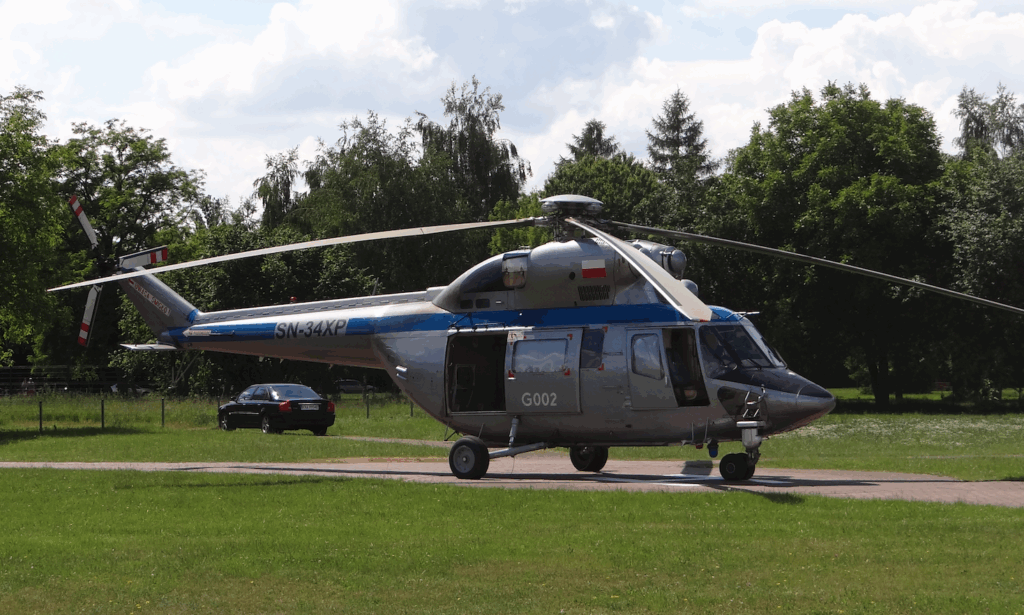
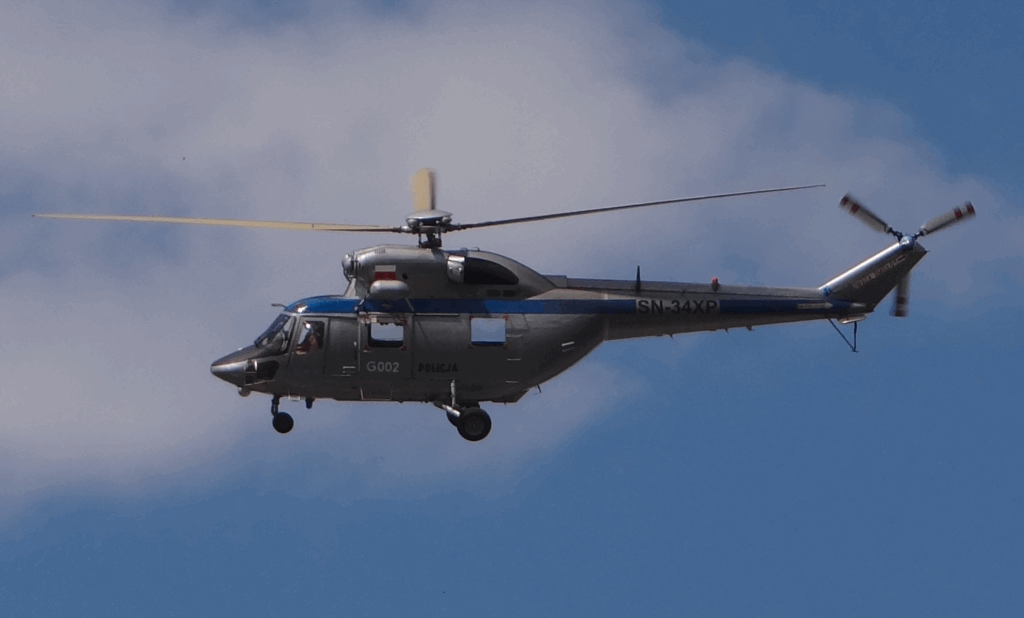
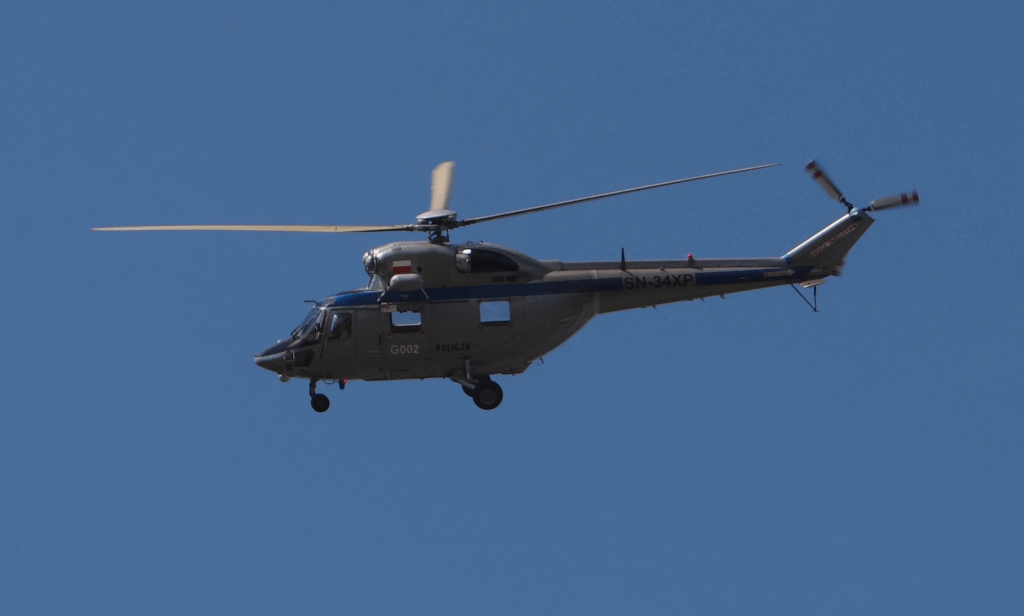
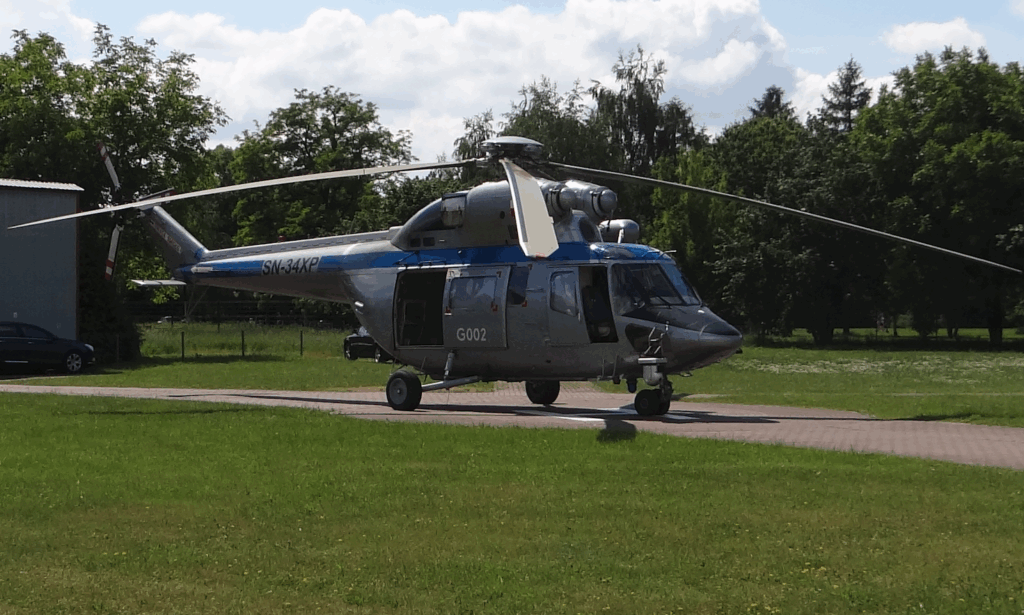
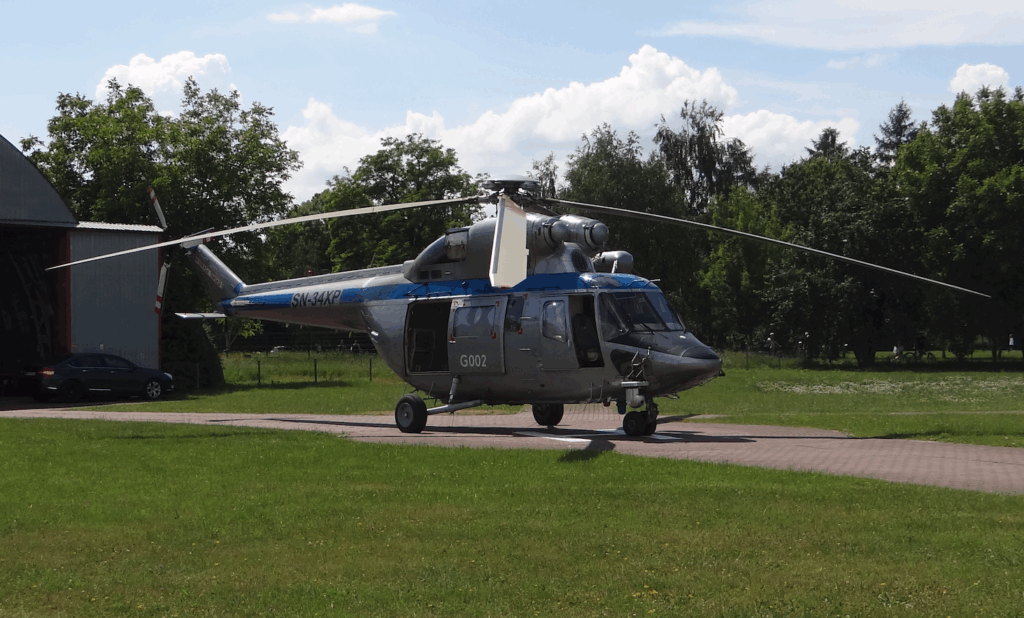
PZL-Sokół helicopter.
As we write these sentences (2025), the career of the PZL W-3 Sokół helicopter is slowly coming to an end. Therefore, let us remember that in the times of the Polish People’s Republic, Poland was one of six countries in the world that produced its own helicopters. The PZL W-3 Sokół helicopter was the largest and most refined Polish design.
At the end of the 1960s, work on a larger helicopter than the PZL Mi-2 helicopter was considered in Świdnik. However, the political atmosphere was unfavorable. However, a group of designers led by Master of Science in Engineering Zbyszko Kodłubaj worked. The idea was to create a medium-sized helicopter, but definitely larger than the Mi-2. It was to be a multi-role helicopter in the following versions: passenger, transport, medical and training. Both with single and double controls.
In 1972, for the first time, a group of designers from WSK PZL Świdnik went to Moscow to the Mil office. Polish engineers had with them a preliminary design with the working designation W-3. Such were the realities in the times of the Polish People’s Republic. In 1974, a historic breakthrough in the development of the WSK PZL Świdnik company took place. At that time, work was officially started on a new Polish helicopter, which received the designation PZL W-3 Sokół. In the communist press, at that time, they spoke of the first Polish helicopter, passing over in silence the work on helicopters; JK-1 Trzmiel, Gil-2/3, BŻ-4 Żuk and SM-4 Łątka. The fact is that PZL W-3 Sokół was the first to enter serial production, which was launched in 1988.
Work on the new helicopter, which received the designation “600”, officially began in May 1974. The team was headed by MSc. Engineer Zbyszko Kodłubaj, and was then headed by MSc. Engineer Stanisław Kamiński, who was called the “father” of the Sokół. Ultimately, the helicopter’s designation was officially adopted as W-3. In the press, the helicopter was commonly referred to as PZL-Sokół.
Representatives of the communist government in Poland could not imagine working on the helicopter without consulting specialists from CCCP, and especially engineer Marat Tyszczenka. Engineer Marat Tyszczenka took over as director of the Mil design office in 1970, after the death of Michał Mil (1909-1970). Polish engineers traveled to Moscow many times. There, the basic design assumptions of the PZL-Sokół were analyzed. This procedure is justified because a significant part of the future production was to go to CCCP. In the autumn of 1975, the preliminary design stage of the PZL-Sokół helicopter was completed.
A mock-up of the PZL-Sokół helicopter was made at the PZL Communication Equipment Research and Development Centre in Świdnik. A few months later, in 1976, the so-called mock-up commission met. It consisted of about 50 specialists from various fields. In general, the commission accepted the helicopter concept and design. A relatively small number of elements that needed to be changed or improved were reported. They were included in the prototype workshop documentation. In parallel, helicopter components were prepared for static and fatigue tests.
The size of the cargo cabin was important, as it was to accommodate 12 people. Final dimensions; length 3.20 (3.70) m, width 1.56 (1.60) m, height 1.40 m. Access to the cargo cabin is provided by sliding doors on the starboard side (slightly behind) and the port side (slightly in front). The door on the starboard side measures 1.25 m x 1.20 m. A crane (winch) is provided in the cargo cabin. The sanitary version was designed to transport four patients on stretchers and two medical personnel. The cockpit is separated from the passenger cabin by equipment cabinets, but there is a passage between both cabins. In the rear of the fuselage there are further helicopter equipment compartments and a luggage compartment. The fuselage is largely joined by welding, which has replaced the common riveting. However, riveting could not be completely eliminated. The horizontal stabilizer is movable. It was kinematic coupled with the control of the general pitch of the main rotor, which improves the stability and longitudinal controllability of the helicopter. Three-support landing gear. Front with two wheels on a common axle, measuring 400 x 150 mm. Main landing gear with single wheels, measuring 500 x 250 mm. The possibility of easy installation of floats or skis was envisaged.
PZL-10 W engines.
The engines were placed above the cargo hold cabin. The drive is provided by two PZL-10 W turbine engines. They are a modification of the Soviet TWD-10 engines, which were developed as a drive for the Antonov An-28 aircraft. The engine was developed by the PZL Communication Equipment Research and Development Center in Rzeszów. The design novelty was the mounting of the engines directly to the sides of the main gearbox and the frame under the gearbox. This solution has great advantages. It reduces the level of noise, vibrations of the structure and the risk of fire. The take-off power of one PZL-10 W engine is 640 kW (870 HP). The extraordinary power used in the event of a failure of the second engine is 735.5 kW (1,000 HP). (Data from 1984).
In Rzeszów, the work on the PZL-10 W engine was led by engineer Hubert Nowak. In 1986, serial production of PZL-10 W engines was launched in Rzeszów. The PZL-10 W power turbine is an adaptation of the Glushenko TWD-10B turbine, developed in the Omsk Engine Design Office in 1970, for the propulsion of aircraft such as the An-28 (M-28 Bryza) or An-3. The production of these engines came to Poland together with the license for the production of An-28 aircraft. After the privatization of WSK PZL Rzeszów, the owner of the plant became Pratt-Whitney. The engine was then equipped with a FADEC electronic control system.
The drive to the rear tail rotor is transferred via a transmission shaft made of duralumin tubes. The clutches are made as multi-spline splines, instead of the previously used Cardan joints.
Engine covers are used for servicing the engine, which, when opened, constitute a platform for technical workers. A similar solution is used in several other helicopters; Mil Mi-6, Mil Mi-8. The helicopter’s fuselage also has handles and steps to enable airport servicing of the helicopter without repair platforms. The helicopter’s fuel tanks are of the soft type, made of thin rubberized fabric. The PZL-Sokół helicopter has an automatic system that maintains the appropriate engine turbine shaft speeds, which makes piloting much easier. It is also possible to switch to manual control.
The PZL-Sokół helicopter’s main rotor has four blades. The blades are made of glass fiber saturated with epoxy resin. The blade is protected against icing by an electro-resistance heating system. The blade tips are shaped to minimize edge losses. The main rotor’s diameter is 15.70 m and is as small as possible to ensure the helicopter’s assumed parameters. The PZL-Sokół helicopter’s tail rotor is a three-blade rotor with a diameter of 3.00 m. The blades are made of glass fiber saturated with epoxy resin. The hub is made of titanium. The hydraulic system for controlling the tail rotor uses a signal to warn the pilot against sudden maneuvers.
The W-3 PZL-Sokół helicopter has been adapted for day and night flights. For safety reasons, many installations and systems have been doubled, and some are even tripled. The helicopter uses a two-channel automatic pilot. The designed period between repairs of the helicopter is 1,500 hours. The service life of the helicopter’s main structural units is 4,500 hours. The general technical service life of the helicopter is 9,000 hours.
The Research and Development Centre in Świdnik and the WSK PZL Świdnik Plant were responsible for creating the helicopter. Other scientific and industrial centres also participated in the project. The engines and transmissions were developed by WSK Rzeszów. The hydraulic and fuel systems were developed by WSK Hydral from Wrocław. The fans and radiators were developed at WSK Kraków on Wrocławska Street. The equipment and aggregates were developed at WSK II Warsaw. The light alloy castings were made at the Gorzyce Plant. The landing gear was designed and calculated by the Institute of Aviation. Some of the rotor head elements were made by the Rolling Bearings Plant in Kraśnik. The rubber fuel tanks were made at the Rubber Industry Plant in Wolbrom. The windscreens and all other windows were made jointly by the AGH University of Science and Technology in Kraków and the Institute of Glass and Ceramics in Kraków on Lipowa Street.
1979.
The first prototype, No. 300101, was completed in 1978. On November 16, 1979, the PZL-Sokół No. 300102 helicopter made its first flight. Engineer Wiesław Mercik was the test pilot. Engineer Tomasz Zakrzewski was on board, operating the measuring equipment. The first flight consisted of taking off, performing limited maneuvers in the air, and landing. The helicopter’s first flight was a result of the adopted schedule, which was difficult to maintain. The helicopter simply had to be lifted into the air to prove that PZL-Sokół could fly. This resulted from the need to include a flight test program in the following year, and thus appropriate financing. The helicopter’s engines were not fully prepared for the first flight. Therefore, the first flight program was minimal. Thus began the first stage of flight tests.
Further work. 1982.
The introduction of martial law in Poland by the communists, under the leadership of General Wojciech Jaruzelski, resulted in a slowdown in work on the helicopter. The main reason was the inability to travel on business and the suspension of the transport of non-strategic goods. It was not until May 1982 that the helicopter designers returned to flight tests. At that time, a series of tests were performed, which were planned for the autumn and winter of 1981.
In November 1984, series production was launched. In the opinion of the crew, it took too long, and not because of technical problems, but political ones. There were organizational problems, and the timeliness of deliveries from cooperators also failed.
The third machine, No. 300103, registration SP-PSB, made its official first flight on May 6, 1982, with the crew consisting of pilot engineer Wiesław Mercik, pilot engineer Zbigniew Dąbski.
The fourth prototype No. 300104 registration SP-PSC, made its first flight on July 24, 1984. The fifth prototype No. 300105, registration SP-PSD, was flown on June 4, 1984. The sixth prototype No. 300106, registration SP-PSE, was flown on November 26, 1984. In 1985, there were already 6 prototypes in WSK PZL Świdnik.
The first two prototypes did not fly, except for one flight of helicopter No. 300102. They were used to conduct ground tests on them. In critical places of the PZL-Sokół helicopter, hundreds of strain gauges were installed, the information from which was recorded on magnetic media and processed in the computing center. The results were used to improve the design and eliminate weak points of the design.
Four more PZL-Sokół helicopters were used for air tests. After the martial law period (December 13, 1981), from the autumn of 1982, flight tests were intensified. During test flights, all important data was collected on magnetic media, from several hundred sensors. Then, they were processed using computers. A full picture of the behavior of the airframe and powerplant was obtained. The results obtained were used to improve piloting techniques so as not to exceed permissible loads or critical flight states. In the following months, only information relevant to specific flight phases was collected. The focus was on selected evolutions and maneuvers.
Much attention was paid to the main rotor, which is always the main source of vibrations. As a result of the tests, several major and minor changes were made. The effect of the team’s intensive work was, among other things, a greater payload, which increased from 1,200 kg to 1,800 kg. Similarly, the external lifting capacity increased from 1,500 kg to 1,950 kg. The helicopter’s cruising speed increased from 220 km/h to 230-235 km/h. The fuel and control system was electronically modified, with the participation of the PZL Hydral plant from Wrocław.
Several significant changes were introduced to the power unit and its surroundings. The air intakes to the engines were changed. Several elements of the main rotor head were changed. A new element was added to the fuselage, behind the rotor. The side air intakes for cooling the power unit were rebuilt. They are now larger and more efficient.
The creator of the helicopter is MSc. Engineer Stanisław Kamiński.
The helicopter’s chief designer, MSc. Eng. Stanisław Kamiński, when asked by a journalist about thresholds and barriers in 1984, immediately mentioned – “the annoying, strange atmosphere of disbelief that we are able to build a good helicopter. It accompanied the team from the very beginning. But even today (1984) it makes itself felt. Basically, I can only count on 30-40 people, the most involved in this program. I will mention the closest ones: leading designer Eng. Bolesław Majerczyk, computational engineer MSc. Eng. Roman Herman, equipment engineer Stanisław Bielak, control systems engineer Piotr Kobus, aerodynamicist MSc. Jan Bronowicz, fuselage designer MSc. Eng. Henryk Czerwiński, chief technologist Eng. Henryk Pać, flight tests MSc. Eng. Bogusław Maryniak and PhD. Eng. Władysław Bubień, directors of the research and development plant MSc. Eng. Roman Kalinowski and MSc. Eng. Tadeusz Różyc. A large contribution The helicopter was created by the pilots: engineer pilot Wiesław Mercik, MSc. engineer pilot Zbigniew Dąbski and engineer pilot Jerzy Dyczkowski.”
Master of Science Stanisław Kamiński was born on 25 March 1936, in Bełżyce, about 30 km west of Lublin. He completed primary school there. He then graduated from Hetman Jan Zamoyski High School in Lublin. He then studied at the Warsaw University of Technology, at the Faculty of Power and Aeronautical Engineering, from which he graduated in 1962. He obtained his Master of Science in Aircraft Engineering from Professor Franciszek Misztal. In 1960, he began working at the WSK design office in Świdnik. Then he moved to the WSK Research and Development Centre. As a designer, he performed all calculations of aircraft structures. Then he became the head of the laminated rotor blade section. In turn, he was appointed the main designer of the PZL-Sokół helicopter, replacing Master of Science Zbyszko Kodłubaj. In addition to his design work, in the period 1963-1964, he was a teacher at the company’s vocational-technical school in Świdnik. Later, he was a lecturer at the Higher School of Engineering in Lublin. He taught classes on material strength. During this time, he also obtained a first-degree specialization in the field of airframe construction. He is the author of eight patents, two of which were used in practice in the development of a main rotor. He is the author of several publications on aviation topics. He completed internships at CCCP and the UK. Master of Science in Engineering Stanisław Kamiński is the author of designs for laminated air fans for the steel industry. He was awarded and honored many times. Stanisław Kamiński died very young, after a long illness on January 18, 1991. He was buried in the cemetery at Majdanek (sector S3Z6, row 1, number 28).
Further helicopter research.
By 1985, PZL-Sokół helicopters had spent about 9,000 hours on tests. In December 1984, PZL-Sokół prototype No. 6 (No. 300106, registration SP-PSE) flew to CCCP for tests by local specialists. This was necessary because CCCP was to be the main recipient of future production. The helicopter underwent tests at the CCCP “Gromov” Civil Aviation Institute in Zhukovsky near Moscow. It was then relocated to Baku on the Caspian Sea. There, tests were carried out; high-altitude, high-temperature and in very strong winds. The wind speed was about 20 m/s. PZL-Sokół passed these tests positively, still having a large safety margin. Then the helicopter was relocated to Yakutsk on the Lena River. There, at the military training ground, the helicopter underwent extremely low temperature tests, which were around -45 degrees C. As a result of these tests, the anti-icing system was modified.
The PZL-Sokół No. 5 prototype (No. 300105, registration SP-PSD) was modified to be able to operate in extremely low temperatures. On January 4, 1985, the PZL-Sokół SP-PSD No. 5 helicopter flew to the far north in the CCCP. The stage flight, from Świdnik, via Lviv, Minsk, Moscow and other airports, was approximately 2,600 km long. The destination was the town of Syktyvar, in the Komi district. Syktyvar is located 1,300 km north-east of Moscow. There is a winter military training ground there. On board the helicopter was equipment developed by the Civil Aviation Institute CCCP “Gromov” in Zhukovsky. The helicopter windows developed by scientists from AGH in Krakow and the Institute of Glass and Ceramics in Krakow on Lipowa Street proved their usefulness in extremely low temperatures. The windows are of multi-layer construction. The resistance layer is sputtered onto one of the glass layers in a vacuum chamber. Heating and electrical elements are also applied to the leading edges of the main rotor blades and the tail rotor. The Institute of Precision Mechanics contributed to this topic.
Assessment of the PZL-Sokół helicopter by Western Countries.
As early as 1985, the Western press highly evaluated the PZL-Sokół design from WSK PZL Świdnik. There was a lot of interest, but it was a long way from import. The West placed the PZL-Sokół helicopter between the American Bell 412 (from 1979, takes 14 passengers) and the French Aerospatiale SA 330 Puma (from 1965, takes 17 passengers).
For these comparisons, specialists calculated data that are not generally given in normal T-T data. For example, the ratio of take-off mass to payload, or the ratio of take-off mass to power of the power unit, or the ratio of range to fuel consumption. But this is how helicopters can be compared more or less. From these calculations it was noticed that in terms of efficiency PZL-Sokół is better than Aerospatiale SA 330 Puma. Its engine power is better used. True, absolute numbers show the advantage of Aerospatiale SA 330 Puma, in terms of payload, speed, altitude and power of the power unit, but by this line of reasoning everyone should buy the Mil Mi-6 helicopter, but in reality no one wanted it.
The comparison of the PZL-Sokół with the Bell 412 was not much different. Experts noticed that the Bell 412 is lighter and can carry 14 passengers. It also has a more powerful power unit; 2 x 843 kW. However, it turned out that the Bell 412 is slower than the PZL-Sokół, both in terms of cruising speed and climb rate. However, the range of the Bell 412 is much greater; 609 miles (980 km).
Another competitor was the Westland Lynx helicopter (1971), a multi-role military helicopter designed by the British manufacturer Westland. It was also produced under license by the French manufacturer Aerospatiale, for use in France. In 1986, pilot John Egginton set a world speed record for a helicopter over a distance of 15-25 km. The speed achieved was 400.87 km/h. The helicopter owes this result to the rigid construction of the blades and the unique design of the main rotor head. Two Rolls-Royce 42-1 engines, with a power of 2 x 746 kW. The Westland Lynx helicopter has similar parameters of size, load capacity and altitude as the PZL-Sokół. However, it clearly exceeds the PZL-Sokół in speed and range (over 1,050 km without additional tanks). About 500 Westland Lynx units were built in various versions.
The Sikorsky S-76 Spirit helicopter (1977) was also a competitor. Powered by two Alisson engines with a power of 2 x 470 kW (2 x 650 HP). This is a smaller helicopter in terms of weight. It has a slightly shorter range, due to the smaller amount of fuel in the tanks (748 km). However, its maximum speed is about 350 km/h.
In conclusion, it should be noted that the PZL-Sokół undoubtedly did not differ significantly in parameters from Western helicopters. The Polish helicopter could easily compete with them. What could be improved is the efficiency of the engines to make them more economical. However, in this matter the designers had their hands tied – “Russian engine, or none at all”. However, the PZL-Sokół competed in price and durability of the design.
1986
In 1986, the first four production helicopters, from the so-called information series, were included in the flight tests. In total, as many as 8 helicopters participated in the air tests. They spent thousands of hours in the air and performed several thousand take-offs and landings. This procedure surprised the designers from CCCP very much. They claimed that 2-3 helicopters were enough for the tests. The problem was that the Muscovites changed the requirements from time to time, and the schedule was not corrected. Pilot Jerzy Petruczynik joined the team of test pilots as the fourth pilot.
The requirements set by the Muscovites were high. Ambient temperatures in the range of -60 degrees Celsius to +50 degrees Celsius. It was clear that CCCP intended to use the PZL-Sokół from Vorkuta to Almaty (Alma-Ata). And also at high-mountain airports, in thin air. It was to fly over deserts and the sea. It should fly at a wind speed of 30 m/s, or 108 km/h. There is no such helicopter in the world.
The PZL-Sokół underwent further tests at CCCP in Dushanbe in Tajikistan. The Polish team worked under the leadership of engineer Bogusław Maryniak. There were mountainous and desert conditions and high temperatures there. So the conditions were very difficult, not only in terms of thin air, but above all in conditions of heavy dust. The engines and electronic equipment worked in extreme conditions. Overall, the helicopter performed well and passed the test. However, the workload per hour of flight increased by over 100%, and the engine service life was significantly shortened.
The PZL-Sokół underwent further tests in Irkutsk, near Lake Baikal, where the pilot captain Bolesław Orliński landed on his way back from Japan in 1926. There, the PZL-Sokół underwent tests at low temperatures from -20 degrees Celsius to -40 degrees Celsius. The helicopter performed well. The most failures were noted in rubber elements, which lose their elasticity and crack at low temperatures.
1987
In 1987, further tests of the rotor and its blades were carried out in Poland. The aim was to test blade flutter at maximum flight speeds. The PZL-Sokół helicopter reached a speed of 305 km/h with a clear blade flutter phenomenon. Therefore, the final limit, maximum speed was set at 270 km/h. Although the operating speed was left at 260 km/h. At that time, the PZL-Sokół also flew in an overloaded version. The take-off weight was even 7,500 kg, although the helicopter was to be certified for a maximum weight of 6,000 – 6,400 kg.
1988
At that time, MSc. engineer Stanisław Kamiński was no longer leading the team, which was a big loss for the program. However, the program was so advanced that a positive end to this stage was expected, ending with the issuance of a certificate. However, it was already known at that time that the Polish economy led by the communists was struggling with significant problems and the future serial production of PZL-Sokół would not be so smooth. However, more disturbing information came from CCCP and PZL Mielec. Colleagues from Mielec reported that CCCP was not paying for the delivered PZL An-28 aircraft.
The PZL-Sokół helicopter underwent state tests between December 1988 and May 1989. The helicopters performed over 120 flights, in a time of about 110 hours.
For operational tests, PZL-Sokół helicopters flew once again to the CCCP, and once again to the town of Syktyvar, in the Komi district, and to Arkhangelsk on the White Sea. The next test site was Baku, and then about ten other locations in the CCCP. The scope of the program was enormous. The Muscovites themselves called the PZL-Sokół “the most tested helicopter in the world.” Despite this, the Muscovites issued their certificate only in 1992, after the collapse of the CCCP. This was just before the FAI issued the certificate. The reader can draw their own conclusions.
The Chief Inspectorate of Civil Aviation issued a temporary certificate on September 26, 1988, which allowed serial production to continue. At the same time, development of a medical and armed version for the Polish Army began.
1990
It has been 16 years since the PZL-Sokół program was launched. It has been 11 years since the PZL-Sokół flight. It was a long time ago. The main recipient destroyed its weak economy. PZL Świdnik had to look for sales markets itself. The company had to learn how to trade. Present offers for sales, servicing and distribution of spare parts. It was not difficult, because PZL-Sokół is an excellent helicopter. Although there were voices criticizing the helicopter, that, for example, replacing the engine in PZL-Sokół takes two days, which is unacceptable for a military helicopter. PZL-Świdnik employees proved that this operation can be done in three and a half hours. You just have to want to and know what you are doing.
The helicopter’s height, which allegedly disqualified it from being a military helicopter, was also criticized. The critics forgot that some low helicopters had a bad reputation among ground personnel and were called “guillotine heads”.
The PZL-Sokół entered service in Poland, as well as the Czech Republic, Burma, Spain, South Korea, the United Arab Emirates, Germany, Vietnam, the Philippines and Russia. A total of about 150 PZL-Sokół machines were built.
2000
The Second Gulf War, also known as the Iraq War, lasted from March 20, 2003 until the official end of combat operations by the United States on December 18, 2011. The Polish Army, which participated in stabilization missions in Iraq (mainly as part of the Polish Military Contingent), used PZL W-3 Sokół helicopters in transport and medical missions. In 2003, Poland sent a military contingent as part of the anti-terrorist coalition, immediately after the invasion began. Poland was responsible for, among other things, the sector in southern Iraq, around the city of Al-Kut. The mission was stabilization in nature and consisted of maintaining security, helping with reconstruction, and training Iraqi security forces. In 2008, Poland ended its mission in Iraq and withdrew its military.
In July 2007, an agreement was signed with China for licensed production of the PZL-Sokół in China at a new factory in Jiangxi Province. The contract was for the production of 150 units. The first was to be built in 2010.
In 2012, the first information reached Poland about the initiative of the Ukrainian Motor Sich concern from Zaporozhye to modernize the PZL-Sokół helicopter. The helicopter was to receive new engines and new control systems. Instead of Pratt-Whitney PZL-10 W engines, which already have electronic control. In the first variant, the engines were to be replaced with modern MS-500. In the second variant, it was planned to use much more powerful engines, a new gearbox and a new rotor with lighter composite blades. The Ukrainians wanted to establish a Polish-Ukrainian company. Export was planned to Africa, Asia and the Middle East. Due to the lack of interest from Poland, the Motor Sich plant purchased two used helicopters in South Korea. In reality, the MS-500 engine is not a breakthrough. It has a fuel consumption of 260 kg/hp compared to 268 kg/hp for the PZL-10 W. The MS-500 engine has a power of 698.72 kW (950 hp), while the PZL-10 W engine has a power of 662 kW (900.07 hp).
In 2014, the modernization of the PZL W-3RM rescue helicopters began, which received a digital engine control system, an automatic identification system for vessels AIS, new rescue equipment, new thermal imaging cameras coupled with searchlights and a new paint job.
In 2016, during the World Youth Day, Pope Francis used the VIP version of the Sokół W-3WA helicopter from Świdnik. For the duration of the World Youth Day, a special aviation component was created, which is responsible for handling flights during this event. It consists of 90 people, not only pilots, but also people responsible for technical support. They are commanded by Colonel Pilot Stanisław Kondrat, who normally heads the 1st Transport Aviation Base in Warsaw. The officer spent over 3,200 hours at the controls of helicopters.
Modernization of W-3 helicopters together with the retrofitting of the SAR version. On September 16, 2019, information was provided about the possible modernization of PZL W-3 helicopters. The W-3 helicopters will be equipped, among other things, with rescue and medical equipment intended for lifting victims from the site of a disaster. This is the result of the signed contract for the modernization of 4 helicopters to the W-3WA SAR version, along with the transfer of a logistics package. The contract with the Communication Equipment Factory “PZL-Świdnik” S.A. was concluded by the Armament Inspectorate. According to the contract, the delivery dates for the modernized helicopters were set for 2021-2022. The value of the contract is PLN 99.5 million gross. The W-3WA SAR helicopters, intended for performing search and rescue tasks, will be delivered to Search and Rescue Groups within the structures of the Polish Air Force.
Currently (2025), there is no doubt that the twilight of the PZL W-3 Sokół helicopters is coming. Realistically, the helicopter has proven itself. It had a high ability to survive on the battlefield. It was adapted to perform missions during the day and at night. It had integrated communication, navigation and weapon systems based on the mission computer and digital data transmission buses and multi-function monitors. It had a spacious cabin with an area of 7 m2, large, sliding doors on both sides of the cabin, facilitating landing missions and equipped with a set for landing on a line. Two PZL-10W engines, with a power of 2 x 888 HP, with the FADEC system and a 4-axis autopilot guaranteeing excellent performance. VHF, UHF, HF, ICS communication system with information coding. Full compatibility with NVG goggles. INS GPS navigation system, digital map, Tacan, VOR, ILS, MB.
T-T data: Take-off weight 6,400 kg 14,110 lb. Total length 18.79 m. Total height 5.14 m. Rotor diameter 15.70 m. Maximum speed 235 km/h, at sea level. Range 730 km. Flight time 4 hours 12 minutes.
Written by Karol Placha Hetman

